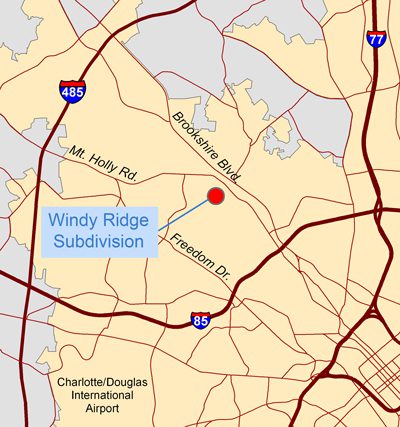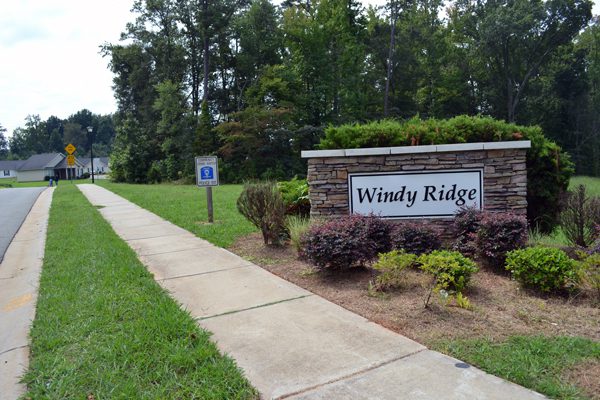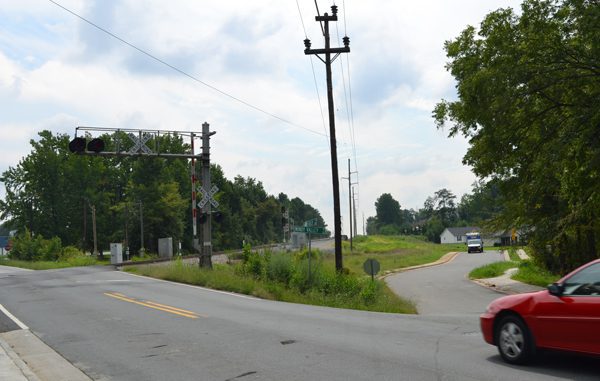Windy Ridge: A neighborhood built to fail

In Charlotte, one neighborhood more than any other came to represent the housing crisis. Built between 2002 and 2004, the Windy Ridge neighborhood of 133 small, single-family homes fell victim. By 2008, 60 percent of the neighborhood’s homes were in foreclosure. Crime rates rose, property values plummeted and the homeowners association couldn’t afford to keep the streetlights on. The Atlantic magazine dubbed the northwest Charlotte neighborhood “The Next Slum.”
In the upcoming July 2014 issue of Applied Geography, UNC Charlotte researchers Janni Sorensen, Jose Gamez and Melissa Currie revisit Windy Ridge. Although predatory lending and subprime borrowing are the usual suspects in the foreclosure crisis, the three researchers look beyond those explanations. Analyzing the City of Charlotte’s planning approval process and what they call its “growth machine” culture, Sorensen, Gamez and Currie come to one main conclusion: Windy Ridge was built to fail.
PlanCharlotte questioned the authors after their journal article was published online, about their research and conclusions. Their answers, below, were edited for clarity and brevity.
Q. You write that Windy Ridge is an example of “poor land use decisions within a growth machine environment.” What do you mean?
Melissa Currie: Economic development theory describes “growth machine” politics (sometimes called “smokestack-chasing”) as an environment in which organizations work together to pursue common interests, putting aside differences to bring about mutual growth. In the paper, we discuss the growth machine environment as evident in (Charlotte’s) near carte-blanche cooperation (through its planning, utilities and economic development departments and its governmental leaders) with the private land development and banking industries.
This opened the door to a flood of residential development, which in many cases was poorly designed and substandard. The fact that Windy Ridge – a property surrounded by heavy industry, railroads and environmental hazards – was rezoned from industrial use to residential is so illogical it seems something that would occur only in a growth-machine environment.
Jose Gamez: Current land-use zoning takes little into account concerning the quality of the built environment. The zoning deals only with use (residential, commercial, industrial), which does not address the quality of the places we build. For example, urban design professionals have moved beyond land use to spatial form (what kinds of physical places/spaces we might create, in which multiple uses might occur).
In the pro-growth climate of the early 2000s, [adding] more neighborhoods seems to have been equated with the overall good of the city. Questions were not raised about the kinds of neighborhoods, what kinds of places we were building or where. This seems to be a contributing factor in Windy Ridge’s struggle today. Since Windy Ridge was a residential development, the project type fit within general development plan guidelines. The project was in compliance with development codes and was allowed to go ahead. In hindsight, this seems like something that should be revisited.
Janni Sorensen: An important role of planners must be to reflect on future effects from development decisions. The complete lack of reflection on what it would be like to live in this neighborhood after it was built, as well as who would likely live there and that population’s needs, exemplifies a growth machine model that disregards the public interest and equates any growth with positive development. There is no balance in the process, no taking into account social, economic and environmental concerns. The entire process is driven by the desire for growth.
Q. You note that Windy Ridge was approved as a housing subdivision even though it’s near four former superfund or hazardous waste sites, two of them within a half mile. Are environmental hazards even considered during Charlotte’s planning and subdivision approval process?
Currie: Formal Environmental Impact Statements are required for government construction projects, and with local development, environmental issues are usually included with a proposal. Those typically deal with such things as the presence of wetlands, streams or steep slopes. Environmental issues with adjacent land uses, however, are rarely considered unless brought up by adjoining residents during the approval process.
Gamez: It is not clear that, at the time of Windy Ridge’s construction, existing surrounding uses were taken into account in determining the suitability of the site.
Q. You say Windy Ridge “is a clear case of environmental (in)justice.” Why did you conclude this?
Currie: The environmental justice movement focuses on the inequitable environmental burden borne by certain groups, such as racial minorities, the poor, or other disadvantaged populations. Historically, locally unwanted land uses, called LULUs, have been  put in areas whose residents have little political power – often poor and minority areas. LULUs may be solid waste transfer facilities, wastewater treatment facilities, heavy manufacturing or other things perceived to pose a hazard or to reduce property values.
put in areas whose residents have little political power – often poor and minority areas. LULUs may be solid waste transfer facilities, wastewater treatment facilities, heavy manufacturing or other things perceived to pose a hazard or to reduce property values.
Numerous environmental hazards surround Windy Ridge (including four former EPA Superfund sites), in addition to freight rail lines on three sides, as well as a water treatment plant, concrete manufacturing and paper processing plants. All those uses and documented polluters existed before the rezoning for, and then construction of, Windy Ridge. That may in this case settle an oft-asked question of which came first: the LULU or the low-income neighborhood?
Gamez: Researchers have examined the relationships between, for example, toxic landscapes and communities of low wealth and have often found that the two are in close geographic proximity to one another. This type of relationship is one indicator of socio-spatial inequality.
Sorensen: The dis-amenities were there before (Windy Ridge) was approved. It can be argued that a thorough reflection in the planning process would have easily revealed that predominantly low-income people would be the likely future residents. The outcome of the development process is a segregated (by race and class) neighborhood disproportionately affected by problematic land uses nearby.
Q. What does the Windy Ridge experience imply about the growing dependence on HOAs to manage services traditionally managed by local government?
Currie: This may be one of the most important takeaways from our study of Windy Ridge: Some types of neighborhood functions do not belong in the purview of an HOA. When an HOA has power and responsibility over crucial neighborhood functions but does not fulfill those obligations, the consequences can be quite grave.
There is no safety net for residents, as the iron-clad nature of laws governing HOAs are nearly impossible to alter. Neighborhoods where a majority of homes are owned by investors are particularly vulnerable. Absentee landlords have less motivation to pay the HOA dues, which fund valuable functions. It is not uncommon for HOAs to be responsible for upkeep and repair of roads, sidewalks, lakes or ponds, common areas and recreational amenities like pools and playgrounds. In Windy Ridge, the HOA was even supposed to maintain streetlights. A lack of available money to maintain those important neighborhood services can lead to decline, lower property values and sometimes serious crime.
Gamez: In this case, homes were initially sold to private investors (individuals and corporations) who were not going to live in the neighborhood. The model of home ownership upon which HOAs are premised was not there in Windy Ridge. This contributed to a rapid decline, once the national economy began to slow.
In addition, large numbers of Windy Ridge residents are renters, so we see a situation emerge in which neighborhood residents do not have a formal voice in the day-to-day workings of the place where they live. If an issue emerges, only homeowners have a voice in an HOA. If homeowners are not around to address issues, then the renters are faced with a situation in which they are powerless.
Sorensen: Tenants of absentee landlords became entirely dependent on the HOA management firms. These firms (the neighborhood went through a couple) ended up paying themselves for their services and doing little else, partly because they had to use a lot of the resources trying to collect dues from absentee landlords whom they struggled to locate.
Residents received little or no services from the HOA dues. Residents wanted the city to be responsible for services, but did not have this option.
Q. What changes in planning and zoning policy should be made to prevent another Windy Ridge?
Currie: Planning policy must re-focus on planning, i.e. preparing for a community’s future and growing population. Traditional zoning practices require separated land-uses and are based on a set of minimums. These must be replaced with those that are guided by a desired built outcome that allows a mix of uses in the same place. In conjunction with changes to zoning policy, planning strategies such as urban service boundaries would allow urban growth that is economically sound, conserves land and encourages efficient use of resources. A healthier model of growth does not accept just any old development because it meets minimum standards. How often does “minimum” equate to “quality?”
Gamez: The City of Charlotte’s land use planning is advisory only. The plans are policy guidelines, not ordinances. That means City Council ultimately can accept or reject the planning department’s advice regarding a development. In Windy Ridge, for example, planners raised concerns about a playground and basketball area taken out of the proposed neighborhood plans after an adjacent neighborhood raised concerns. If our planning culture locally had been more robust, advice from local planners may have had more “teeth” and been taken more seriously. However, planning alone is not the cause of Windy Ridge’s failures. Our market-driven residential development model is also to blame, not just poor lending practices but also speculative development models.
Sorensen: Planning must take seriously the call to be inclusive and represent those who typically do not have much voice in planning processes. In this case, planning could have been the voice that prevented a very fragile population from ending up living in a neighborhood that did not meet their needs. A shift from growth machine to planning for a public good should be intentional about serving those who are often marginalized.
Q. With all its problems, what should happen for Windy Ridge?
Currie: At a minimum, an assessment should determine the level of contamination and pollution that Windy Ridge residents are exposed to. Is the neighborhood even a safe place to live, from a health perspective? The poor construction practices rampant in Windy Ridge, namely erosion and drainage problems, should also be addressed as a part of the public realm.
Gamez: We have to find ways to address the problems places like Windy Ridge face. I say “we” because all Charlotte’s citizens have an interest in making sure all areas of the city are resilient. An uneven geography, with wealth and resources concentrated in one area while others face significant challenges, is a major part of the ongoing problem. This kind of disparity will lead to increasing tensions.
Sorensen: That’s the million-dollar question. I think the only hope, if the neighborhood is determined to be environmentally safe, is to find a way to disband the HOA and make the city responsible for all core services. Charlotte would need to retrofit the neighborhood to better serve the people who live there – play spaces, better bus service, etc. This is obviously not going to happen, so the biggest lesson is that we must stop building Windy Ridge-type developments!